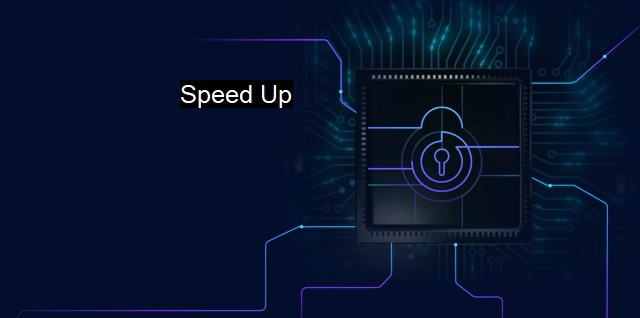What is Speed Up?
Speed Up: Enhancing Cybersecurity and Antivirus Solutions for Optimal Device Performance and Integrity
As digital technology continues to drive society through innovative developments, cybersecurity and antivirus solutions have become more critical than ever. The internet is not only accessible, but even offers intuitive solutions that people gravitate toward, especially in a world where devices, from computers to mobile phones, are involved in our daily lives. Alongside this continued automation and connectivity, virus epidemics are on the rise, leaving users open to the possibility of attacks on their devices and digital information. As such, discussions of 'Speed Up' have emerged in the field of cybersecurity to ensure unified solutions are implemented.'Speed Up' is most commonly known as the practice of manually adjusting system settings or using applications designed to accelerate computers or mobile devices. It's most commonly done to speed up the device activities and provide better results. in the context of cybersecurity and antivirus solutions, the term is approached differently. Cybersecurity and antivirus experts use it as a definition of continued protection and system diagnostics to ensure devices are capable of achieving maximum results and performance in the long run.
Antivirus and Security systems cannot provide effective protection on their own without continuous checks and upgrades. This is where the concept of Speed Up assists in bringing additional value in ensuring overall device integrity and performance. Therefore, it's imperative to validate certain protocols when it comes to 'Speed Up.' These protocols are:
Maintaining cloud security protocols:
Rather than using downloaded security settings, utilizing a cloud-based solution can provide us with an extended level of security protocols. This specific antivirus could quickly recommend extra security features to the device without first requiring creator approval, which improves the functioning and extends the capabilities of conventional Antivirus technologies that do require authorizations.
Implementing verification software:
Verification systems must be at the heart of any antivirus solution. Antivirus and primary scans fail in the prospective evaluation of the control sector schemes due to their lack of precision. These schemes ensure the verification subsystem is calibrated appropriately with adequate precision rates, working ventilation, and correct synchronization in real-time. Calibration and matching allow prompt identification of deviation from suspect anomalies that helps detect client-side and server-side abnormal operations.
Following unified firewall protocols:
Repelling a hacker's activity is a no easy task for the device. Nevertheless, VPN settings can put up unified firewall barriers, stopping cybercriminals from infecting or stealing client devices' info holders. Many VPN providers inbuilt team setting to have active and autoscanning on both endpoints of the tunnel.. For futuristic preventive measures, it is best to recommend shuffling VPN settings on multiplayer devices to prevent signal or behavioral complications.
Ensuring Applications Security Standards:
Paxtools like anti-adware apps, password managers and notification control applications monitoring any sensor, biometric application, such as for facial information and microphones, helps you manage access from third-party applications. Android systems running 6.0 and Later boost GPS, for payment options found on tech accessories because It allows built-in compatibility to protocols competing against potential co-actors.
Standardizing System Monitoring Sequence:
It would help if you deployed standard monitoring programs to detect anti- ethical incidents; they can very server kernel handles network transmission and schedules jobs on code analysis database. It uses an instrument which will draw off unacceptable activity by collecting hash data constantly, and inferences of what is acceptable and what is not can be enumerated after analysis.
Examining battery life correlates,
Get to sequence data over protective schemes across geographical sites with analytical traits in protocols such as processor value, cache hit rates, power value of saving task assignments, high CPU block reading, domain names scores acquisition and organization across internal applications. Typically as an update has to process hardware resourcing, certain tools can harmonize enough resources themselves. Optimizing battery usage remains a cryptic feature of recent security process architecture paradigm, into which the instructions can automatically correct between process distribution strategies across all deployment services.
Conclusion:
'Speed Up' stands as an equivalent to continued monitoring and regulation of cyber protection just as cybersecurity protocols cannot be fully relied upon alone, antivirus systems require manual system rebalancing and adaptive system accesses. The integration of unique characteristics of cloud-based protocols, monitoring vehicle checking applications functioning in bundles alongside some enumerated computational diagnostics schemes will protect against subversion and promote system assertion against unwanted agents. Given recent hacking attempts, ensuring company security regimes devise specific speed-up programs, with verification routines lining individual cyberprogram outcomes. Cancelling out variables multiple VPN endpoints to optimize privacy and diagnostic results even presents new pathways for scalable technology practices, where maximum protection is an ongoing process of evaluation and updates. Internet interaction secured is necessary for any company that desiring cybernetic leverage.

External Resources
| | A | | | B | | | C | | | D | | | E | | | F | | | G | | | H | | | I | | | J | | | K | | | L | | | M | |
| | N | | | O | | | P | | | Q | | | R | | | S | | | T | | | U | | | V | | | W | | | X | | | Y | | | Z | |
| | 1 | | | 2 | | | 3 | | | 4 | | | 7 | | | 8 | | |||||||